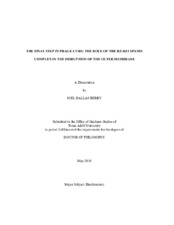| dc.description.abstract | The purpose of the work described in this dissertation is to better understand the role of Rz and Rz1 function with respect to phage lysis. We determined using both a genetic and biochemical approach that the Rz protein is an inner membrane protein containing a single N-terminal transmembrane domain (TMD) with an Nin/Cout topology. Consistent with previous work on Rz1, the Rz1 lipoprotein was found to be localized to the outer membrane (OM).
Following localization, both Rz and Rz1 form homodimers in vivo due to intermolecular disulfide formation. Despite being localized to apposing membranes, the two proteins form a complex. A small number of phages encode a potential single protein equivalent of Rz-Rz1. This protein, termed a spanin, is predicted to tether the inner and outer membranes by a single polypeptide chain. Based on complementation, it was concluded that gp11 from the phage T1 is a functional equivalent of Rz-Rz1. Gp11, and by analogy the Rz-Rz1 two-component spanin complex, threads the meshwork of the PG layer. The presence of an Rz-Rz1 complex, which forms in the presence of peptidoglycan (PG), is supported by in vivo results.
The soluble periplasmic domains of Rz and Rz1, which are dimeric and monomeric respectively, were purified. Circular dichroism analysis indicates that Rz is structured, with significant α-helical content, whereas Rz1, in which 10 out 39 residues are proline, is unstructured. Mixing the proteins results in the formation of a complex with significant new α-helical content. Negative-stain images reveal ~ 25 nm x ~ 4 nm rod-shaped structures.
Holin independent activity of Rz and Rz1 is found to disrupt whole cells. Furthermore, time lapse microscopy of λ and λRzam lysis allows us to conclude that Rz and Rz1 are essential for lysis. These results suggest a model for Rz-Rz1 function which begins with Rz and Rz1 forming a complex through direct interaction prior to holin and endolysin function. Holin-mediated hole formation allows the endolysin to degrade PG which sterically hinders Rz-Rz1 activity. Removal of PG by endolysin degradation thus triggers Rz-Rz1 OM disruption via fusion of the inner and outer membranes. | en |


